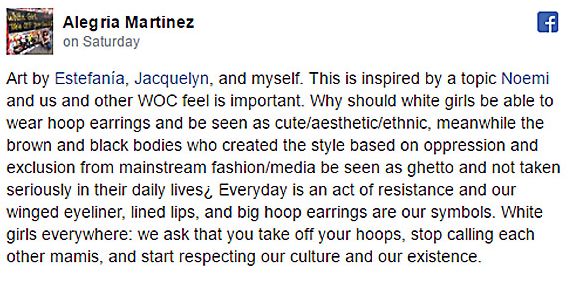
Alegria Martinez poses with graffiti.
The most recent cultural appropriation is that white women should not wear hoop earrings.
The proclamation was made at California’s Pitzer College, where yearly costs are around $66,000 US, when some Hispanic students spray-painted the words “White Girl, take off your hoops!!!” on the campus’ wall.
According to Claremont Independent, when a white student addressed the message, Alegria Martinez, a Pitzer College Resident Assistant (RA) and active member of the “Latinx Student Union” sent out a mass email that stated:
“[T]he art was created by myself and a few other WOC [women of color] after being tired and annoyed with the reoccuring [sic] theme of white women appropriating styles … that belong to the black and brown folks who created the culture. The culture actually comes from a historical background of oppression and exclusion. The black and brown bodies who typically wear hooped earrings, (and other accessories like winged eyeliner, gold name plate necklaces, etc) are typically viewed as ghetto, and are not taken seriously by others in their daily lives. Because of this, I see our winged eyeliner, lined lips, and big hoop earrings serving as symbols [and] as an everyday act of resistance, especially here at the Claremont Colleges. Meanwhile we wonder, why should white girls be able to take part in this culture (wearing hoop earrings just being one case of it) and be seen as cute/aesthetic/ethnic. White people have actually exploited the culture and made it into fashion.”
Martinez followed this up with a post on her Facebook account where she again, re-iterated:
“White girls everywhere: we ask that you take off your hoops, stop calling each other mamis, and start respecting our culture and our existence.”

Alegria Martinez posts on her Facebook about the graffiti in question
Another student, Jacquelyn Aguilera, who also took part in the authoring of the graffiti, responded to the mass email saying:
“If you didn’t create the culture as a coping mechanism for marginalization, take off those hoops, if your feminism isn’t intersectional take off those hoops, if you try to wear mi cultura when the creators can no longer afford it, take off those hoops, if you are incapable of using a search engine and expect other people to educate you, take off those hoops, if you can’t pronounce my name or spell it … take off those hoops / I use “those” instead of “your” because hoops were never “yours” to begin with.”
The history of hoop earrings goes far back; in fact, it is one of the most ancient forms of jewellery that trickled into western fashion. Golden hoops are the earliest archaeological evidence of earrings, which were worn by Sumerian women dating to 2,500 B.C.E. In ancient Egypt, both men and women wore them before the trend spread throughout the Aegean civilisation.
It was not until it reached ancient Greece that specific refinements were added and it is where the careful crafting of hoops really began. Jewellery was not just a mark of fashion, but also wealth.
By the time hoops arrived in Europe, further adjustments and designs developed until it filtered down to the modern-day earrings that we have come to know.
Its ultimate evolution has been a medley of many cultures and races. One may even argue that had it not been for (white) Europeans, the history of hoop earrings may have turned out differently and they may have never made it to the United States to facilitate these students becoming embroiled in this argument.
Fashion and jewellery is something that unites women across the world. It happens each time we embrace the same new trend. To create race division over something that should be, and has been celebrated for hundreds of years, only exacerbates a divide that should have been abolished with the Emancipation Proclamation in 1863.
“Like” and follow me on Facebook for more of my work.
Website: www.jsvondacre.com
* Article originally featured in MerolaMag
